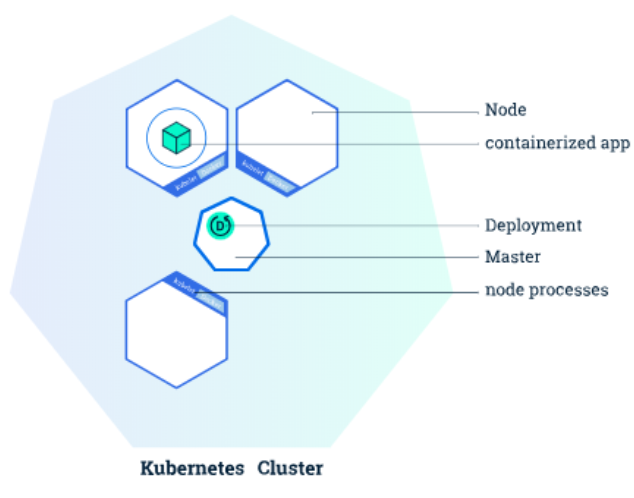Introduction to pods
From container to pods

Let's see how we can deploy a simple container using kubernetes. To do this we need to introduce two k8s resources:
- Pod:
- A pod is a collection of containers sharing a network and mount namespace and is the basic unit of deployment in Kubernetes. All containers in a pod are scheduled on the same node.
- Deployment:
- A deployment is a supervisor for pods, giving you fine-grained control over how and when a new pod version is rolled out as well as rolled back to a previous state.
Before continuing
The docker images used in this demo can be found in:
Create a pod with kubectl
To run a pod all you need is:
kubectl run --generator=run-pod/v1 lookup-pod --image=dciangot/lookup --port=80
If everything went well you can then see your pod running after a while:
kubectl get pods
NAME READY STATUS RESTARTS AGE lookup-pod 1/1 Running 0 1m
Inspect resources
Every k8s resource can be inspected with the command describe. This will provide you with a variety of useful information on the state and cofiguration of the resource. For instance you can get the internal pod network IP of the running container in the pod.
kubectl describe pod lookup-pod | grep IP: IP: 172.17.0.3
Delete
Delete the two pods and pay attention to what happens.
kubectl delete pod lookup-pod
Using manifest files
Any resource can also be created from a yaml or json template.
In case of a pod you can find the configuration file in templates/pods.yml:
apiVersion: v1 kind: Pod metadata: name: lookup-manifest-pod spec: containers: - name: lookup-container image: dciangot/lookup ports: - containerPort: 80 resources: limits: memory: "64Mi" cpu: "500m"
As you can see, is also possible to set limits for the resource to be reserved for the pod.
Now the syntax for creating a resource from a manifest file is:
kubectl create -f templates/k8s/pods.yml
And then take a look to the pod details using describe command:
kubectl describe pod lookup-manifest-pod
And finally remove the pod with:
kubectl delete lookup-manifest-pod
Create a deployment from configuration file
You can find the configuration file for a deployment in templates/deployments.yml:
apiVersion: apps/v1beta1 kind: Deployment metadata: name: lookup-deployment spec: replicas: 1 template: metadata: labels: app: myapp spec: containers: - name: lookup-container-deployment image: dciangot/lookup ports: - containerPort: 80 env: - name: SIMPLE_SERVICE_VERSION value: "1.0" resources: limits: memory: "64Mi" cpu: "500m" - name: probe-container image: dciangot/probe
Here you can see the addition of the replica field where you can specifiy how many replicas of the same file you want.
Also the label metadata is important to organize the application management as we will see next on the k8s service section.
kubectl create -f templates/k8s/deployments.yml
Also, let's try to see the environment variable set inside the container with the kubectl executility.
First of all take and note the pod name:
kubectl get pod -l app=myapp
NAME READY STATUS RESTARTS AGE lookup-deployment-77d5748999-tcbhj 2/2 Running 0 4m11s
Then execute env command inside the container with:
kubectl exec -ti lookup-deployment-77d5748999-tcbhj env -c lookup-container-deployment | grep SIMPLE_SERVICE_VERSION
We can also get to the endpoint from the probe contianer directly on localhost with:
$ kubectl exec -ti lookup-deployment-85b549f8b6-4lgls -c probe-container curl localhost
<h3>Hello World!</h3><b>Hostname:</b> lookup-deployment-85b549f8b6-4lgls<br/>
Update a pod
Try to modify the manifest and then run:
kubectl apply -f templates/deployments.yml
Delete a pod inside a deployment
If you try to remove the pod under the deployment control, what happens?
Before continuing: can I connect outside the pod?
Let's finally create another probe container outside the pod:
kubectl run --generator=run-pod/v1 probe-cluster-pod --image=dciangot/probe
Run curl in the container and check that indeed you can access the endpoint of the pods at:
$ kubectl describe pod lookup-deployment-85b549f8b6-4lgls | grep IP: IP: 10.244.3.6
$ kubectl exec -ti probe-cluster-pod curl 10.244.3.6 <h3>Hello World!</h3><b>Hostname:</b> lookup-deployment-85b549f8b6-4lgls<br/>